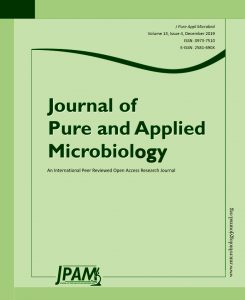Because of the strong interest in the use of bio-products as alternatives to chemically derived antibiotics or antimicrobial agents, passion fruits extracts were evaluated for their antibacterial activity and chemical composition. Various solvent extracts of P. edulis were screened for their antibacterial activity by Agar well diffusion technique against an array of pathogenic bacteria (Gram positive and negative). Macro dilution technique was used to determine the Minimum inhibitory concentration of the potent extracts. Bacterial strain showing significant inhibition was further subjected to scanning electron microcopy (SEM) and the morphological changes induced by extracts were noted. Chemical composition of extracts showing strong antibacterial activity was determined by GC-MS and FTIR analysis. Extracts of Passion fruit (pulp with seeds) show significant inhibitory effects against test isolates but in a variable manner. Amongst all the test isolates Bacillus subtilis showed maximum inhibition followed by E. coli and P. aeruginosa. Ethyl acetate extracts had the least activity against the tested microorganisms. Gas chromatography-mass spectrometry of ethanol extracts showed the presence of important chemicals, such as Tetracosamethyl-cyclododecasiloxane; Dodecanoic acid, 10-methyl-, methyl ester cyclosiloxane, hexadecamethyl; 3-isopropoxy-1,1,1,7,7,7-hexamethyl-3,5,5-tris (trimethylsiloxy)tetrasil; 9-hexadecenoic acid, 9-octadecenyl ester, (Z,Z)- Fourier transform infrared studies revealed important functional groups which included phenols, esters, flavonoids, aromatic compounds, and alcohols. Significant antibacterial activity of the extracts could be attributed to phenolic compounds, esters and other chemical components identified in ethanolic extracts. Scanning electron micrographs of B. subtilis treated with ethanol extracts showed distorted shapes, rough and corrugated cell margins, and aggregations of cells. Our data depict the significant antimicrobial activity of extracts against Gram positive bacteria while the Gram negative bacteria exhibited weak inhibition by all the extracts. Based on our findings, passion fruits can be used in preparations of antimicrobial formulations against Gram positive microorganisms especially B. subtilis.
Passion fruit, pulp, Rind, scanning electron microscopy, Gas chromatography-mass spectrometry, Fourier transform infrared.
© The Author(s) 2019. Open Access. This article is distributed under the terms of the Creative Commons Attribution 4.0 International License which permits unrestricted use, sharing, distribution, and reproduction in any medium, provided you give appropriate credit to the original author(s) and the source, provide a link to the Creative Commons license, and indicate if changes were made.


